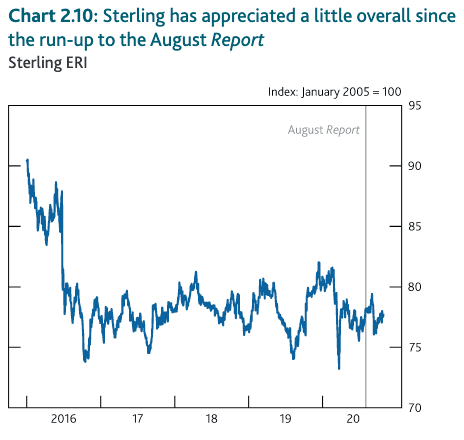UK GDP Forecasts Cut by Bank of England

Image © Adobe Stock
UK economic growth forecasts for the UK economy have been downgraded by the Bank of England, while pointing to a more gradual recovery in growth towards pre-Covid levels.
According to the Bank's Monetary Policy Report, UK GDP growth in the fourth quarter of 2020 is now forecast to decline by 2%, having previously been expected to rise by 3.5%.
GDP forecasts for the third quarter show growth of 16.2%, which is lower than the 18.3% previously assumed.
GDP growth in 2020 is now expected to fall by a larger 11%, which is deeper than the previously forecast -9.5%.
This is a more severe forecast than that made by the European Commission which on Thursday released their Autumn economic forecasts for the Eurozone, EU and UK. EU Commission forecasts show an expectation for growth to decline 10.25% in 2020, meaning the UK is expected to suffer the second-deepest recession in Europe this year, behind Spain.
The economic rebound in 2021 is forecast to be slower than previously assumed owing to renewed lockdown measures that will impact growth in November, with the Bank's economists now seeing growth of +7.25% in 2021 against the +9% forecast previously.
This means that the economy was now not expected to recover back up to its pre-Covid peak until around the end of the first quarter of 2022.
GDP is forecast to read at 3.1% by the end of 2022, a downgrade on previous forecasts for a reading of 2.3%.
Unemployment is meanwhile expected to rise to around 6.3% by the end of the year, which is a smaller rise than that expected in August, largely reflecting the impact of government support schemes.
With regards to the outlook for the Pound, the Bank says the downside risks far outweighs the upside potential.
"News reports about the terms on which the UK and EU will trade from 1 January 2021 has been an important factor driving moves in sterling since August. Sterling fell by 4% in early September, but it has subsequently recovered to a little above its level in the run‑up to the August Report. Market pricing suggests that the outlook for sterling is uncertain: market‑implied sterling volatilities have increased since August and risk reversals suggest that market participants place more weight on a large depreciation than a large appreciation," says the Bank.
Above: The Sterling exchange rate index from the Bank of England which measures the broad-based strength of the Pound by weighing up its main exchange rates.
Regarding inflation, CPI inflation is forecast to rise to 0.9% in March 2021 from the 0.5% increase reported in September.
Concerning the outlook, the Bank's projections assume that developments related to Covid-19 will weigh on spending in the near term, although to a lesser extent than earlier in the year.
"UK activity in the first half of 2021 is also judged likely to be affected by lower trade as firms adjust to the UK and EU’s new trading relationship. Over the forecast period, GDP is projected to recover as the direct impact of Covid-19 on the economy is assumed to wane. Activity is also supported by substantial fiscal and monetary policy actions. The recovery takes time, however, and the risks around the projection are judged to be skewed to the downside," says the Bank.











